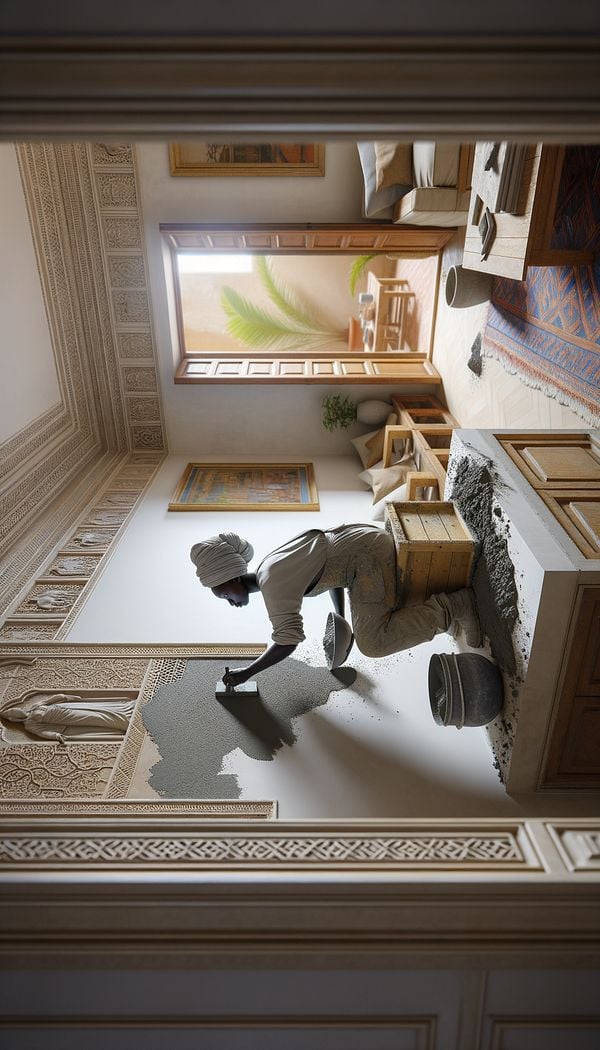What is Plaster?
Plaster is a building material used for coating, protecting, and decorating walls and ceilings.
Description
Plaster is an age-old building and finishing material that has been used for thousands of years. It is a mixture of lime or gypsum, sand, water, and sometimes fibres which is applied wet and hardens to a smooth, durable surface. It has been a favoured material for covering interior walls and ceilings because it provides a seamless finish and can be molded or textured in various ways for decorative effects.
The use of plaster in interior design extends beyond merely providing a smooth surface for painting or wallpapering. Modern plaster can also include a variety of additives to enhance strength, durability, moisture resistance, and even fire resistance. When applied by skilled artisans, plaster can be shaped into intricate details, cornices, ceiling medallions, and other architectural features that add character and elegance to a space.
Environmentally conscious designers and architects value plaster for its sustainability. Made from natural materials, it is non-toxic and can contribute to a healthier indoor environment. Additionally, its thermal properties can enhance energy efficiency in buildings by helping to regulate indoor temperatures.
Despite the advent of drywall and other modern wall coverings, plaster remains a popular choice for high-end residential and heritage restoration projects. Its versatility, durability, and aesthetic appeal make it a timeless material in the field of interior design.
Usage
Traditionally, plaster was applied in three coats over a lath (a framework of wire or narrow strips of wood) to create a strong bond with the wall. However, modern techniques and materials allow for a variety of application methods, including directly onto solid surfaces like concrete blocks or bricks. In contemporary design, plaster is often used to create smooth finishes in living rooms, detailed moldings in dining rooms, and durable surfaces in high-moisture areas like bathrooms.
FAQs
-
Can plaster be used outdoors?
Yes, though typically used indoors for its aesthetic and functional qualities, certain types of plaster that are especially formulated for outdoor use are available. These are more resistant to weather and moisture.
-
How long does plaster take to dry?
The drying time for plaster can vary greatly depending on factors such as the specific type of plaster, the thickness of the application, room temperature, and humidity. On average, it takes about 2 to 3 days for the first two coats to dry sufficiently before applying the finishing coat.
-
Is plaster environmentally friendly?
Yes, plaster is considered environmentally friendly because it is made from natural, readily available materials. Its production has a lower carbon footprint compared to many other building materials, and it contributes to a healthier indoor air quality.
-
Can plaster be painted or wallpapered over?
Absolutely. Once fully dry, plaster provides an excellent smooth surface for painting or the application of wallpaper. However, it's important to apply a suitable primer beforehand to ensure best results.
-
Can plaster be repaired if it cracks?
Yes. Cracks in plaster can be repaired using a plaster compound or a mixture similar to the original plaster. For best results and to ensure the repair blends seamlessly with the surrounding surface, it's often recommended to seek professional help.
Practical Application
Plaster offers a unique combination of aesthetic versatility and durability, making it a valuable material in any interior designer’s toolkit. For those looking to employ plaster in their projects, consider starting with smaller features like creating a focal wall, enhancing a fireplace surround, or adding decorative ceiling elements. Mastering plaster application and repair techniques can also be beneficial, ensuring that both new installations and restorations maintain their beauty over time.
-
Architectural Elements199 articles
-
Design Styles478 articles
-
Materials & Textiles360 articles
-
Wall Treatments & Finishes157 articles
-
Fabrication & Craftsmanship133 articles
-
Persian RugA Persian rug is a handwoven carpet from Iran, known for its intricate designs and high quality.
-
UnityUnity in interior design refers to the harmonious arrangement of elements within a space that creates a cohesive and coherent look.
-
ModularityModularity refers to the design principle of creating components that can be easily combined or separated to adapt to changing needs or spaces.
-
ElizabethanElizabethan refers to an architectural and interior design style from the Elizabethan era in England.
-
UpholsteryUpholstery refers to the material, which can include fabric, padding, webbing, and springs, used to cover furniture.
